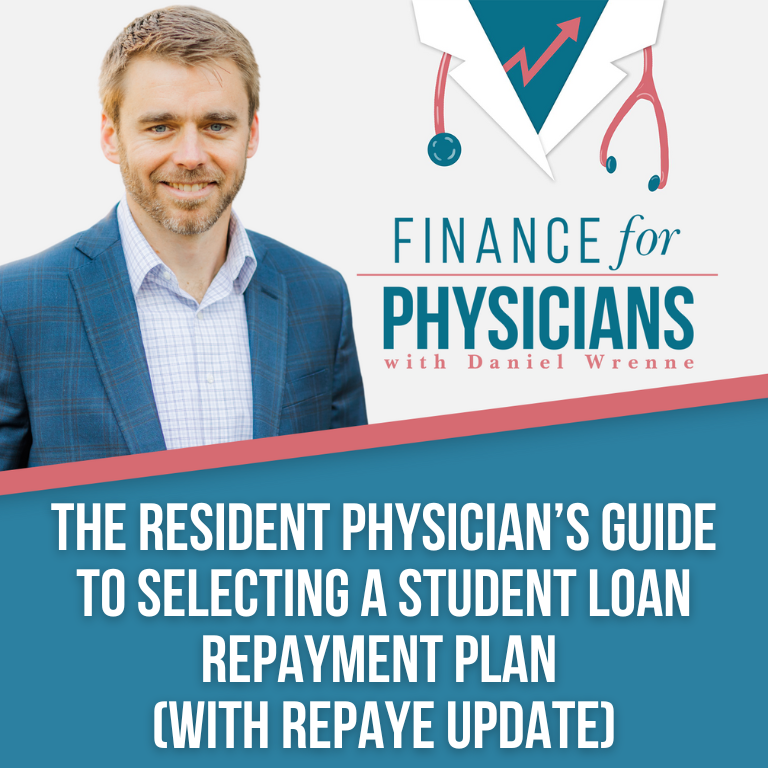For starters, it’s complicated! Check out our Physician’s complete guide to medical school loans for more details. For now, we’re just going to focus on the new repayment plan, RePAYE.
Late in 2015, RePAYE was introduced for new borrowers. This Public Service Loan Forgiveness “PSLF” qualifying repayment plan was also made available to existing borrowers. Young physicians and other professionals going for PSLF should pay attention – especially those using the old IBR plan. The potential value of switching to REPAYE for many is enormous. But it’s not so cut and dry. Every situation is different and the potential benefits will vary based on your specific circumstances. We will cover some of the basic information and scenarios to get you started on maximizing your PSLF.
Borrowers now have a choice between REPAYE, IBR and sometimes PAYE (if loans were originated after October 1st, 2007).
REPAYE
Benefits
- Your payment is 10% of discretionary income and is not capped
- Available to all borrowers
- 50% of your excess unpaid interest is picked up by the government
- You get loan forgiveness under PSLF after 120 payments
- Loan forgiveness after 20 years for undergraduate loans, and 25 years for graduate loans.
Downside
- You no longer have the option of “married filing separately”
- There is no more payment cap
- Interest is capitalized when switching from another plan to REPAYE (but this is not an issue if you’re going for PSLF)
PAYE vs. REPAYE
REPAYE uses the same payment formula as PAYE. This yields the same payment for all single borrowers and some married borrowers. Here are a few of the key differences to consider – most of which favor PAYE:
- PAYE payments are capped at the 10 year standard repayment amount. REPAYE payments have no cap. Therefore, the higher your income (or expected income), and the more debt you have, the more likely PAYE is more advantageous than REPAYE. If you haven’t hit this cap, both repayment plans will have the same payment.
- With PAYE, you can file taxes separately and only include the borrower’s income. REPAYE requires that you always include your spouse’s income. This makes PAYE considerably more beneficial for married borrowers.
- With REPAYE, the government picks up the tab on 50% of the unpaid interest. This is a win for REPAYE.
Choosing Between PAYE and REPAYE
If you’re certainly going for PSLF, PAYE is your best bet. The only benefit of REPAYE over PAYE (the interest subsidy) is irrelevant when going for PSLF. It becomes more tricky the when your future career path is unknown. If you are likely going for PSLF, then PAYE is still probably your best bet. If you’re like NOT going for PSLF, then REPAYE could come into favor. The more likely you are to have to fully repay your loans (and not receive PSLF), the more appealing the REPAYE 50% interest subsidy becomes.
IBR vs REPAYE
Some borrowers aren’t eligible for PAYE and are therefore limited to IBR and REPAYE for PSLF qualification. Here is how IBR compares to REPAYE…
- IBR has a higher payment formula (15% of discretionary income vs 10% for REPAYE). Win for REPAYE.
- IBR (like PAYE) includes a payment cap whereas REPAYE does not. IBR provides value over REPAYE in some high income cases.
- IBR allows for filing separately and using the borrower’s income only (like PAYE) whereas REPAYE does not.
- And like PAYE, IBR doesn’t include a government interest subsidy.
Choosing between IBR and REPAYE
If you’re single (or have a spouse that doesn’t earn an income), going for PSLF, and not expecting to max out IBR because of very high income, REPAYE is a big win. The reduced payments provide tens of thousands of savings for many young physicians with large student loans going for PSLF. If you’re unsure about maxing out IBR, you can run the numbers using the repayment estimator online. Plug in your loan info and expected max earnings. If the IBR total is blank, you are maxed out (and should therefore be cautious with REPAYE).
If you’re in the same scenario as above but you expect to max out IBR, you must run the numbers. Compare the REPAYE savings over IBR before you max out IBR payments with the IBR savings over REPAYE after you max out. Choose the repayment plan that allows for the lowest total repayment. As a side note, currently, you can change between repayment plans. Therefore, you could stick with REPAYE when income is lower and switch to IBR just before it increases or caps out. This would provide the best possible result but also assumes the option to switch repayment plans continues. I suspect it will not.
If you’re married, have a spouse that has income, and you’re going for PSLF, you must consider everything we already mentioned plus the potential savings associated with filing taxes separately and using IBR. In some cases, this provides value that outweighs the payment savings with REPAYE. Consider the resident physicians with a spouse in practice who is making mid six figures… IBR could provide massive value by allowing for separate tax filing and using the borrower’s income only. It’s a more complicated analysis to consider, but totally worth it. Making the best choice here will often result in tens of thousands of dollars in value.
When PSLF qualification is in question, it changes the game. Now is the time to look at your situation. Don’t assume you’re in the best repayment plan. Take some time or hire an expert to help you analyze all the options and come up with your best possible plan.
